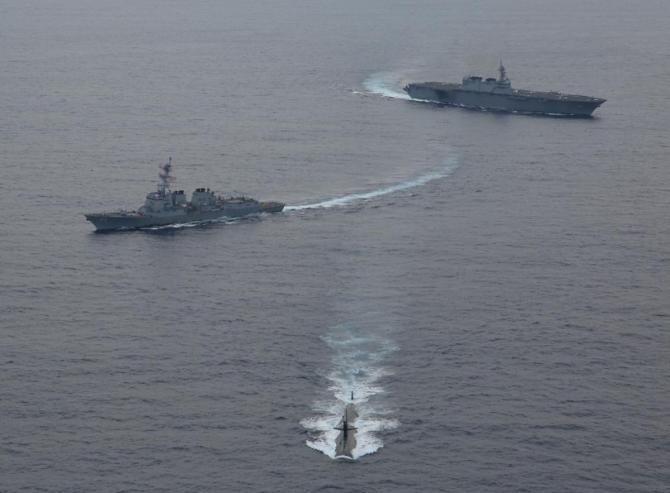At any time, there is a need to operationally deploy two aircraft carriers in the vast Indian Ocean, asserts Vice Admiral Premvir Das (retd).

External Affairs Minister S Jaishankar has spoken repeatedly of the Indo-Pacific. Both as the person in charge of our foreign policy and as a scholar of acknowledged strategic understanding, the minister has few equals and it will be useful to identify the four seminal points made in his articulations.
One, that the Indo-Pacific is yesterday's reality, not of tomorrow;
Two, the environment is predominantly maritime;
Three, that India had to be a key player in the Indian Ocean Region and,
Four, that we had to bring our Indo-Pacific interests in sync with other like-minded countries.
At this same time, the Chief of Defence Staff has reportedly advocated the creation of a Maritime Theatre. Apparently, this structure will comprise the existing Eastern and Western Naval Commands of the Navy as also the tri-service Andaman and Nicobar Command.
The geographic space that this theatre will encompass is not known, nor its terms of reference, though maintenance of freedom of the seas, safe movement of commerce and humanitarian assistance and disaster relief (HADR) are talked of in a generic sense.
No enemies have been identified but it is assumed that China and Pakistan would fall in that category.
Neither of the two steps can be questioned. What can only be debated is how prepared India is to deal with them.
Maritime power is not just about navies or what they can do but also permeates across our overseas trade, HADR and linkages with other littorals.
Clearly, none of these responsibilities can be assumed credibly unless there is capacity to deploy in the Indian Ocean Region and to be seen as a useful and reliable partner. This depends on a few factors, some variable and the others not amenable to change. The first of the latter is geography.
Landlocked countries are obviously non-starters in the business of maritime power. Even those with some coastline, should have easy access to open waters. Germany, France, Russia have all operated reasonably strong navies but without being able to establish credible power at sea.
Two centuries ago, France was defeated decisively by the British both in the Battles of Trafalgar and Nile despite its superiority in numbers of ships.
Russia could sail its fleet all the way across the world from the Baltic Sea to the Sea of Japan in 1917, but faced humiliating defeat there at the hands of the Japanese.
Germany could build powerful battleships like the Tirpitz and Bismarck, but that did not get its navy to roam the Atlantic.
On the other hand, the British navy dominated the required maritime space for close to three centuries; Japan could do a Pearl Harbour and even Australia contributed overseas in the wars in Korea and Vietnam.
All three countries are island nations with access to seas around them. The USA has land borders to its north and south but open waters on both sides have enabled it to become a dominant maritime power globally.
The other essential attribute of maritime power is will of the people, or rather government, to have an assertive mindset. This alone can permit deployments overseas.
This is what allowed Margaret Thatcher to deploy the British navy (including the aircraft carrier HMS Hermes, later to become INS Viraat) 8,000 miles away from home to 'liberate' a few tiny islands, which flew its flag but were taken over by Argentina.
In the ensuing war in the Falklands, which were only 200 miles from the coast, the Argentines sank a few British warships while losing one of their own but had to surrender, ultimately succumbing to their adversary's superior maritime power.
It is this will to be assertive and consequently have the required capabilities that determine the ability of a country to play a credible role in the maritime space.
So, one can ask, how does India measure up?
Geographically, we are very well placed with open seas on three sides and island territories to act as force multipliers.
As for capabilities, we are able to act as 'first responders' in HADR scenarios in the northern part of the Indian Ocean Region. For ensuring free movement of seaborne commerce, we have to act in concert with other countries as was done during the Somali piracy.
It is in our ability to be assertive in the maritime domain where there are gaps. Integral air power at sea is one such area.
At any time, there is a need to operationally deploy two aircraft carriers in this vast ocean space for which three are needed, given that at best, two-thirds of the force can be kept fit for sea duty.
The number will, hopefully, reach two (from one at present) by 2023 when the Vikrant, under construction at Kochi, is commissioned, but three are nowhere on the horizon.
The Coast Guard, very useful in HADR scenarios, also needs muscle. The navy's share of the defence budget, which grew 13 per cent to 18 per cent from 1987 to the early part of this century is now down to 14 per cent.
The defence allocation itself has not been able to rise beyond 2 per cent of the gross domestic product in the last six years and it is not reasonable to expect any great increase in the next few years. So, realistically speaking, capabilities will not be in sync with the desired maritime power profile.
As for the will of the government, the last and only time some of it was shown was in 1987 when we sent the Indian Peace Keeping Force to Sri Lanka. Its purpose was to support the Tamils there but it ended up fighting them and was withdrawn with some loss of face.
In sum, if we need to match up to the articulations of Dr Jaishankar and the CDS and play a credible role in the Indo-Pacific, something more than the existing capabilities will be required.
Like China, India is essentially a continental mindset country but while the former has begun to make course correction, we are still to start thinking maritime.
To paraphrase the minister, the time to do so was yesterday, not tomorrow.
Vice Admiral Premvir Das (retd) has served as member of the National Security Advisory Board.












 © 2025
© 2025